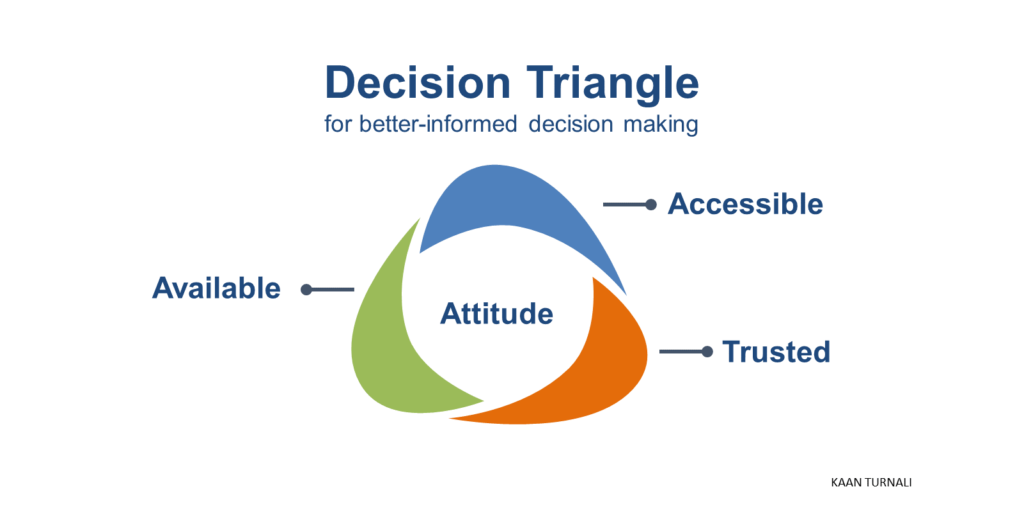Digital transformation brings about an incredible opportunity for fostering a data-driven culture and enabling faster, better-informed decision making. Although data’s role in making better-informed business decisions is undeniable, more data does not necessarily guarantee better business decisions.
Fueled by advances in technology and a deluge of data, the digital universe continues to shape and influence how leaders perceive, leverage or ignore data, which is a fundamental part of making decisions in the digital economy. Real-time, predictive, big data, mobile, cloud, the Internet of Things, and machine learning –these technologies and more are enabling organizations of all sizes leverage analytics solutions in all dimensions.
However, psychology and attitude—which play a larger role in tackling data-entangled decisions—are often overlooked. Many executives are still hesitant and apprehensive about relying on data-driven decisions, choosing instead to depend solely on nonquantitative factors.
Better-informed decisions vs. better decisions
Better-informed leaders don’t always make better decisions, but better decisions almost always start with better-informed leaders.
It’s important to understand that the concept of better-informed decisions is distinctly different than the notion of better decisions. The former generally involves information discovery and the resulting choices we make when data is available, accessible, and trusted—a condition I refer as the “decision triangle” that supports better-informed decision making. On the other hand, the latter often results from an action we take that may or may not rely on data.
This same principle equally applies to individuals and their everyday decisions as consumers, patients, and customers. As long as the final decision lies with us (humans, that is), we can either choose to ignore the data or use it in our decision making.
If we simply choose to ignore the data, even the presence of a perfect triangle can neither change nor prevent uninformed or less-informed decisions. Thus, better-informed decisions are not analogous to better decisions.
Data-driven decisions do not require blind faith in data
There is a common misconception that data-driven decisions are blind decisions solely data-reliant and incompatible with other nonquantitative methods of decision making. This notion is misleading and relies on the misinterpreted assumption of what better-informed decision making is about and how it’s applied to data-driven analyses.
There is nothing in the decision-making process (scientific or otherwise) that prohibits the ability to challenge consensus or pursue alternative views of a question in light of the data points presented. Instead, better-informed decisions rely on data points to provide breadth and depth for a complete view of the problem we are trying to solve.
Rather, questions about the data are encouraged. This approach allows us to align our understanding of the unknown by painting, as close as possible, an accurate picture of reality. By removing argumentative and biased angles, while acquiring vital insight about our key assumptions that are validated with relevant and reliable data points, critical thinking becomes a key ingredient in evaluating our data outlets and improving our decision sockets.
Data-driven decisions are not linear
Better-informed decisions often require multi-dimensional analyses. They can’t be simply built on data-driven exercises that are linear. Plus, they lack the prudence needed to pursue a holistic view of the problem. Moreover, once a problem is uncovered or an objective for a new goal is defined, different phases unfold quickly to shape the next steps.
Typically, this first phase is fashioned out of an immediate reaction to a threat or opportunity, where preliminary figures tend to accompany known assumptions. Together, they form our initial direction. Data is still considered entangled (fluid) during this early stage, but the requirement for additional information can be outlined.
In some cases, however, the decision may be already made. And when this happens, the effort to gather additional data for further analysis is nothing more than a futile exercise.
Bottom line
We need to use data to support and strengthen our arguments, not arguments to support and justify data.
Data-entangled decision making boils down to one principle: The person who is ultimately in charge of the final decision is the one who decides how to use any insight derived from all available data. For the decision maker, in the end, there are typically three outcomes:
- The conclusion is supported by data, and we choose to take it into account when making the final decision.
- The conclusion is supported by data, and we choose to ignore it.
- The conclusion isn’t or can’t be supported by data, and we are left to our judgment to make the decision.
Better-informed decisions often start with a strong appetite for data followed by a healthy dose of skepticism. If available, our collective insight becomes the guiding light for decisions enhanced by data. When we can’t find and rely on data, we are left to decide for ourselves—forcing us to seek wisdom in our own experiences and to depend on our intuition to fill the void.
This post was originally published on turnali.com




